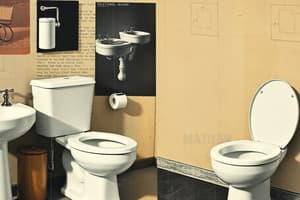Podcast
Questions and Answers
Plumbing fixtures must be made from porous materials to enhance cleanliness.
Plumbing fixtures must be made from porous materials to enhance cleanliness.
False (B)
The National Plumbing Code of the Philippines was promulgated in 1959.
The National Plumbing Code of the Philippines was promulgated in 1959.
True (A)
Every plumbing fixture must be supplied with water at a pressure sufficient to function without undue noise.
Every plumbing fixture must be supplied with water at a pressure sufficient to function without undue noise.
True (A)
House Bill No. 962 became the R.A. 1378 'Plumbing Law of the Philippines' in 1955.
House Bill No. 962 became the R.A. 1378 'Plumbing Law of the Philippines' in 1955.
Every plumbing fixture connected to the drainage system must have a gas-sealed trap.
Every plumbing fixture connected to the drainage system must have a gas-sealed trap.
In the Philippines, the plumbing trade was recognized by the government for the first time in 1902.
In the Philippines, the plumbing trade was recognized by the government for the first time in 1902.
The plumbing code in the Philippines requires that each family dwelling must have at least two water closets.
The plumbing code in the Philippines requires that each family dwelling must have at least two water closets.
The Manila City Ordinance 2411 was enacted after the establishment of the National Master Plumbers Association.
The Manila City Ordinance 2411 was enacted after the establishment of the National Master Plumbers Association.
Plumbing systems are designed to use the maximum quantity of water necessary for proper functioning.
Plumbing systems are designed to use the maximum quantity of water necessary for proper functioning.
During the process of plumbing installation, devices for heating water are prohibited from having any safety measures against explosion.
During the process of plumbing installation, devices for heating water are prohibited from having any safety measures against explosion.
Flashcards are hidden until you start studying
Study Notes
Plumbing Overview
- Plumbing involves the installation of pipes, fixtures, and apparatus in buildings to transport liquids and substances safely and efficiently.
- A proper plumbing system must operate with sufficient water volume and pressure while minimizing noise.
Plumbing Systems and Regulations
- Plumbing design should use minimal water while ensuring effective performance and maintenance.
- Devices for heating and storing water must prevent explosion risks associated with overheating.
- Buildings near public sewers are required to connect their plumbing fixtures to the sewer system.
Historical Context in the Philippines
- The Plumbing Trade was officially recognized in 1902 in Manila; John F. Haas became the first Chief of Plumbing Construction and Inspection.
- The Plumbing Code of the United States served as a foundation for Manila's plumbing regulations.
- NAMPAP was established in 1935 to serve as the national association for master plumbers in the Philippines.
Legal Framework
- Manila City Ordinance 2411 introduced the local Plumbing Code.
- R.A. 1378, known as the Plumbing Law, was enacted in 1955 to formalize plumbing regulations nationwide.
- The National Plumbing Code of 1959 provided critical guidelines until the updated Plumbing Code of 1999 was approved.
Plumbing Fixtures and Materials
- Every dwelling must have essential fixtures: a water closet, kitchen sink, lavatory, and bathtub or shower for hygiene and sanitation.
- Plumbing fixtures must be smooth, non-absorbent, and situated within ventilated spaces to prevent contamination.
Drainage Systems
- Drainage systems must be designed to prevent fouling, and deposits of solids, with adequate cleanouts for maintenance.
- All drainage piping should use durable, approved materials to ensure reliability and safety.
Trap Systems and Ventilation
- Fixtures connected to drainage systems require water-sealed traps to prevent sewer gas escape.
- The drainage system should maintain proper air circulation without allowing siphonage or aspiration under normal conditions.
Testing and Quality Control
- Plumbing systems must undergo water and air tests to detect leaks and workmanship defects.
- Measures must be taken to block harmful substances from entering drainage systems that could disrupt sewage disposal.
Sanitation and Safety
- Adequate protection against backflow of sewage is vital to ensure food, water, and sterile items remain uncontaminated.
- Water closets must be installed in adequately lit and ventilated areas to ensure hygiene and usability.
Studying That Suits You
Use AI to generate personalized quizzes and flashcards to suit your learning preferences.




